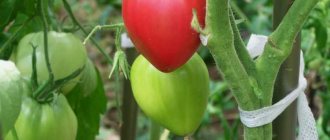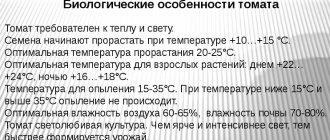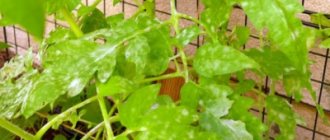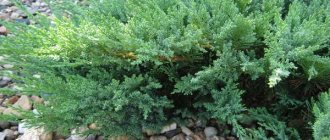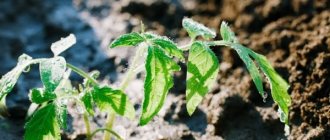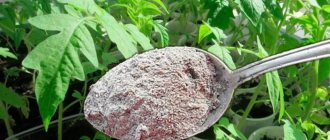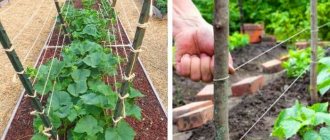Tomatoes produce high yields only with proper care, an integral part of which is timely application of fertilizers.
Tomato seedlings need a constant supply of not only the main elements, but also certain microelements, among which magnesium occupies a special position.
How to detect a deficiency and save the plant in time? Let's figure it out together.
When and why do tomatoes need it?
Magnesium is actively involved in the process of plant photosynthesis throughout the entire season and is part of the chlorophyll molecule.
Also, this microelement ensures the correct metabolism of tomato bushes, helping to absorb potassium, phosphorus and nitrogen .
During fruiting and filling of tomatoes, a sufficient amount of magnesium improves the taste characteristics of the crop (promotes the accumulation of sugars). Since magnesium plays an important role in plant development, it is necessary to periodically add it to the soil even in the absence of deficiency symptoms.
What it is
Magnesium sulfate , or magnesium sulfate, is a chlorine-free water-soluble fertilizer, a salt of magnesium and sulfuric acid. Intended purpose: root and foliar feeding. The fertilizer can also be applied to the soil to improve soil quality.
Formula – MgSO4 . Magnesium in the fertilizer is contained in the form of oxide. Active ingredients in magnesium sulfate:
- from 17% magnesium - the element is necessary for the formation of chlorophyll in the leaves, protein synthesis, and complete absorption of calcium and phosphorus; component-builder of plant tissue at the cellular level; participant in the synthesis of ascorbic acid (vitamin C), essential oils;
- 13.5% sulfur – activator of biological processes, synthesizes vegetable protein; protects against fungal, viral and bacterial infections, strengthens phytoimmunity, resists the appearance of garden pests (wireworms, spider mites, aphids).
Physical characteristics and mechanical properties of magnesium sulfate (according to technical specifications, GOST 4523-77):
- appearance – white crystalline powder (or colorless substance);
- production – natural marine-type solutions, solid salt deposits;
- natural sources (raw materials) - sea water, minerals kieserite (up to 30% magnesium oxide), epsolite-bitter salt (more than 82-84%), hexahydrite; natural raw materials contain at least 28-30% sulfur;
- in anhydrous form it decomposes into magnesium oxide, sulfur oxide and oxygen;
- water-soluble drug, dissolves at a temperature of 20C;
- the inorganic compound forms crystalline hydrates (1, 2, 3, 4, 5, 6, 7 and 12 water molecules);
- magnesium sulfate 7-water is available in the form of a white crystalline powder (mass fraction not less than 99%); contains zinc impurities, phosphates, heavy metals in small quantities.
Beneficial features
Magnesium is the basis of the green pigment of the plant. Fertilizing with magnesium sulfate promotes the complete absorption of phosphorus and calcium and ensures rich color of leaves and stems throughout the season.
Without sulfur, metabolic processes are blocked. In particular, nitrogen absorption depends on sulfur, a trace filler element.
This is the most common microfertilizer:
- plants urgently need magnesium as a fundamental component for the formation of chlorophyll;
- sulfur ensures metabolic processes in cells and tissues.
Magnesium sulfate is especially loved by garden plants:
- cabbage;
- tomatoes;
- pepper;
- eggplant;
- onion garlic;
- sugar beet;
- legumes
, berry bushes and garden trees produce juicy, sweet berries and fruits. The quality composition of fruits improves (the amount of ascorbic acid, sugar, essential oils, vitamin D, starch increases).
The dense crown of ornamental shrubs especially needs additional nutrition. Brown needles, small leaves of conifers are brownish-brown - a clear lack of the “mineral of life” magnesium.
Fertilizing with magnesium sulfate saves plants in poor lighting conditions (indoor flowers, greenhouse crops), and with a lack of sunlight in open areas.
Signs of deficiency with photos
Tomatoes tend to react to a lack of one or another substance in the soil. In case of magnesium deficiency, their leaf blades begin to curl upward from the edges, and the leaf surface turns yellow between the veins.
The manifestation of symptoms of magnesium starvation of tomatoes begins on the lower leaves of the bushes; over time, the leaves of the middle tier are affected.
Below you can see photographs of plants that, to one degree or another, lack this element.
Your tomatoes clearly do not look healthy, but the signs are different from those in the photo? Then we recommend that you read our material about nutritional deficiencies in tomatoes. There is a reference table that will help you find out what substances your plants are lacking.
Effect of magnesium sulfate
Magnesium sulfate has a positive effect on the taste of tomato fruits, potatoes and cucumbers by stimulating the formation of sugar and starch in them. At the same time, the yield increases, in some cases it can even be higher than the varietal characteristics.
The fertilizer is recommended for use when there are signs of magnesium deficiency in the soil:
- yellowing of leaf blades on the lower tier of bushes and trees;
- the formation of small buds, their partial shedding;
- delay in growth of seedlings and seedlings;
- the formation of marble sheets - the appearance of white veins on their surface;
- the appearance of brown, yellow or brown spots along the edges of the leaf.
Magnesium is an essential substance in photosynthesis. It helps the plant absorb phosphorus and calcium, leads to an increase in the amount of ascorbic acid in fruits, and ensures the normal level of essential oils necessary for uniform and timely ripening of the crop.
With a magnesium deficiency, plants cannot fully develop, so systematic application of magnesium sulfate is necessary.
What to feed in case of shortage
Most often, to eliminate magnesium deficiency, gardeners apply mineral fertilizers with a high magnesium content.
Fertilizers with this microelement
Magnesium sulfate (magnesium sulfate) . It is a combination of magnesium (17%) and sulfur (13%).
Magnesium sulfate is used on all types of soils except acidic ones. The effectiveness of its use is confirmed even on sandy soils, from which all elements are quickly washed out.
Fertilizer can be applied during spring digging of ridges, and also as a top dressing: root fertilizing - 30 g of magnesium sulfate per bucket of water, and foliar fertilizing - 15 g per bucket of water. The dosage must be strictly observed, otherwise the plants may get leaf burns.
Magnesium nitrate (magnesium nitrate) . Consists of nitrogen and magnesium. This saltpeter is used in cases of acute magnesium deficiency - it promotes the rapid supply of the necessary microelement and the growth of green mass.
The most effective use of nitrate is on neutral soils.
For spraying, dilute 20 g of fertilizer per bucket of water, for root feeding - 10 g per bucket of water. Between feedings you need to take a break of two weeks. They are stopped two weeks before harvest.
Gardeners often use another fertilizer - “Mag-Bor”; it is especially effective in combination with other fertilizers.
Ready-made mineral supplements
Calimagnesia. The magnesium content in the fertilizer is 10%, in addition there is sulfur and potassium. If there is a lack of magnesium nutrition in tomatoes, the bushes are sprayed with Kalimag solution at the rate of 20 g per bucket of water. The disadvantage of the fertilizer is the chlorine content (1-3%), to which tomatoes are very sensitive.
Organic fertilizers
Some organic fertilizers are characterized by a high content of magnesium; they can be used to feed tomatoes if there is a lack of this microelement.
Dolomite flour. Contains a large amount of magnesium – 40%.
It is applied before planting tomatoes to fertilize and deoxidize the soil.
During magnesium starvation, the bushes can be shed with so-called dolomite milk - a solution of flour in water, taken in a ratio of 1:10.
Chicken droppings. The magnesium content in it is 0.8%. It is added in granular form before planting tomatoes in the ground, and an infusion of chicken manure is used as a top dressing.
At the budding stage, fertilizing is carried out: chicken manure is diluted in water in a ratio of 1:50, left to ferment for two weeks, and then the resulting concentrate is added to water in a ratio of 1:20, respectively.
Watering is carried out at the root, the consumption of the working solution is 0.5/bush.
Ash. Ash contains three important magnesium compounds - silicate, sulfate, carbonate. To water tomato bushes at the root, you can use a solution of ash, simply adding 100 g of the substance to a bucket of water.
For spraying, ash and water are taken in equal parts and boiled for 0.5 hours. The concentrate must be diluted with water in a ratio of 1:3, add a little laundry soap and leave for 24 hours.
Lack of nutrition in tomatoes is a fairly common occurrence. Read about the main symptoms of deficiency of other microelements - zinc, potassium, copper, boron in the materials at the links.
Compatibility with other fertilizers
To prevent an acute shortage of magnesium and sulfur, the fertilizer is used together with nitrogen fertilizers. In the first half of the season, it helps in the absorption of nitrogen fertilizers. For example, combined application with urea will give plants a good start.
Combination with various humates (sodium, potassium) as a growth stimulant is acceptable.
Magnesium sulfate goes well with mineral supplements:
- In tank mixtures, fertilizer is mixed with phosphate fertilizers.
- Simultaneous application with dolomite and complex fertilizers (azophoska, borophosphoska, diammofoska) is acceptable.
- The combination of magnesium and boron is beneficial for strawberries and strawberries. In late April-early May, when leaves appear, leaf spraying is the most effective way to feed berry bushes. Special preparations are produced (for example, MagBor). For feeding, it is enough to dilute 1 tsp. of the drug in 10 liters of water and treat the plants leaf by leaf.
Advice from an experienced farmer
Tomatoes in indoor plantings often experience heat stress. Signs of heat stroke are leaves curling upward, “into a boat.”
For feeding plants and against excessive dry air, along with shading and chalk treatments of the bush in the greenhouse, a comprehensive application of magnesium sulfate and silicon additives will help. The source of silicon is liquid glass, silicate glue.
Reference . Magnesium and silicon, according to plant experts, significantly increase the heat resistance of crops. In the summer heat, green mass can withstand a temperature increase of 5-7C above permissible standards.
Preparation of the rescue solution:
- 1 tsp. silicate glue;
- 1 tbsp. l. magnesium sulfate;
- the ingredients are mixed, dissolved in 1 liter of water;
- Add 8-9 liters of settled water at room temperature to the mother solution, stirring continuously.
Spray the tomatoes with the prepared solution.
Caution . Silicate solutions are incompatible with tank mixtures of microelements:
- iron;
- copper;
- calcium.
How to apply fertilizer
How to properly compensate for the deficiency of this substance? Magnesium is easily absorbed by tomatoes in liquid form.
When applying a microelement dry, its action will have to be activated by frequent watering.
Therefore, gardeners always prepare solutions of magnesium-containing fertilizers and apply them under the roots or spray them on the surface of the bushes.
Efficiency for plants
Magnesium sulfate is used quite often for plants as a fertilizer and for prevention. It can be used as an independent substance or in combination with other preparations to improve soil or photosynthesis and development.
The effect that fertilizer has on plants gives them a marketable appearance. That is why, if there is a plot of land of 5 or more hectares, gardeners and farmers choose magnesium sulfate. For people who have a household, it is not necessary to buy a stove heating substance.
It will come from wood ash, which is a combustion waste. Furnace ash contains all the necessary microelements. But there is one “BUT”: magnesium will be enough, but sulfur will have to be added.
Root method
In order to carry out root feeding containing magnesium without harming tomatoes, it is necessary to take into account several nuances.
- The required amount of fertilizer is diluted in warm water (its temperature should not be lower than +250C).
- Carefully, trying not to get on the above-ground part of the bush, the solution is poured into the root zone of the tomato. To do this, it is recommended to remove the diffuser from the watering can.
And although the element that enters the soil will be absorbed by the plant much longer than if it gets on the leaves, for tomatoes, mainly root feeding is carried out.
How does acute magnesium deficiency manifest in plants?
Magnesium is an indispensable helper for plants; it protects leaves from the scorching sun, roots from frost, and fruits from rotting. With a lack of magnesium, crops are less resistant to external influences. It is advisable to use magnesium sulfate fertilizer if plants have the following symptoms:
- the edges of the leaves acquire a brown tint and dry out;
- the foliage is covered with a pattern reminiscent of marble;
- leaves fall;
- the fruits do not ripen due to the inability of the plants to absorb nutrition from the soil.
The signs listed above are detected when there is a lack of magnesium. If there is not enough sulfur in the soil, the plant grows slower, the leaves turn yellow and discolored. Also, if there is a lack of sulfur, the work of bacteria in the soil is disrupted, and nutrients are not processed and cannot become complete food for crops.
Foliar method
Spraying with fertilizers containing magnesium is highly effective: the microelement is absorbed much faster , therefore, in case of pronounced magnesium starvation, it is recommended to carry out foliar feeding.
For spraying, it is better to choose cloudy days, or apply fertilizer early in the morning or in the evening.
Under no circumstances should you spray tomatoes in active sun. It is also not recommended to foliarly fertilize tomatoes during hot weather or strong winds.
Important! Excessive moisture in the green mass of tomatoes often provokes diseases of the bushes, so the frequency of foliar feeding should be strictly controlled.
Benefits of a mineral supplement
Fertilizers with magnesium are necessary for the normal growth and development of fruit and vegetable crops. The trace element is responsible for photosynthesis and is a fundamental component in the formation of chlorophyll.
Thanks to it, the absorption of calcium and phosphorus occurs faster and more efficiently, the percentage of ascorbic acid increases, and the fats and essential oils necessary for fruit ripening accumulate.
Magnesium is needed for the construction of tissues of any plants, normal metabolism, and improvement of the taste characteristics of fruits. It supports and accelerates development processes, improves immunity, protects plants from stress (in hot or cold weather), and helps to survive in difficult conditions.
The substance is mainly concentrated in the growing parts, but gradually, as they wither, it passes into new ones. Example of a diagram: flowers - ovaries - seeds. In general, the content of the element in crops is small, but this does not detract from its importance for plants. It is as necessary as nitrogen, phosphorus, and potassium. It is no coincidence that many experts equate it with macroelements in value.
An additional advantage of the fertilizer is the presence of sulfur, which is involved in carbohydrate and nitrogen metabolism and helps to increase the resistance of plants to unfavorable climatic conditions. Without this substance, metabolic processes are disrupted and blocked.
Important application details
The instructions for using magnesium-containing mineral fertilizers say that they can and even should be mixed with any others - the effectiveness of fertilizing increases: magnesium promotes better absorption of essential nutrients (nitrogen, phosphorus, potassium).
There is no need to worry about an excess of this microelement in the soil.
When applying it in liquid form at the root of a bush or when planting it in the soil in spring, tomatoes independently dose the required amount of magnesium using the root system.
All excess trace elements remain in the soil and are consumed by plants in the next season. When spraying on foliage, it is important to carry out the exact dosage of magnesium-containing fertilizers, otherwise the green parts of the bush may burn.
Personal precautions when working with magnesium fertilizers are similar to the safety requirements when working with other agrochemicals and fertilizers.
When diluting the solution, you must use gloves and avoid getting the product in your eyes. After finishing the event, you should wash your hands thoroughly. Smoking is prohibited when preparing the solution and feeding.
Magnesium is not one of the main elements, but is also necessary for the proper development and good fruiting of tomatoes. On soil enriched with magnesium, tomato bushes grow healthy, and their fruits have a sweet taste . That is why it is so important to timely apply magnesium-containing fertilizers to this crop.
Advantages and disadvantages
Advantages of magnesium sulfate as a fertilizer:
- absolute compatibility with nitrogen and phosphorus fertilizers, with humic nutrients, and with multicomponent mineral additives;
- there is no nitrogen in the composition, it is added throughout the season (in July and August, nitrogen is undesirable for plants);
- an overdose is practically impossible - the plant will extract exactly as much beneficial nutritional microflora as it needs; the remainder goes into stock;
- an excellent “antidepressant” for plants - the drug protects green mass from aggressive sunlight, increases the resistance of perennials to cold and frost;
- fertilizer is affordable.
The role of magnesium and sulfur in plant life
Despite the tiny portions that participate in plant processes, the influence of the elements cannot be underestimated:
- Magnesium is necessary for photosynthesis; without it, the full formation of chlorophyll is impossible.
- Magnesium combines substances involved in photosynthesis.
- With its help, ATP (adenosine triphosphoric acid) is formed, which serves as a source of energy and is the basis of the genetic memory of plants.
- Sulfur acts as an intermediary in the delivery and assimilation of nitrogen, which, in turn, is responsible for the full growth of green mass.
- Also, sulfur is a direct participant in the formation of amino acids that make up proteins.
With a lack of these elements, the above processes slow down or stop altogether.
They signal that plants lack magnesium and sulfur by changing the size and color of leaves and stems.
Symptoms of elemental deficiency
| Element | Signs |
| Magnesium | · Chlorosis appears on the leaves, as a result of which the color of the underlying tissues becomes pale green or yellow. Dark veins are clearly visible against their background. This not only looks unsightly, but indicates a lack of photosynthesis. In other words, due to a lack of magnesium, the plant cannot produce chlorophyll at full strength. As a result, budding, flowering, and fruiting are inhibited. |
| · If measures are not taken, the process worsens, brown spots appear on the leaf blades, which quickly become dry. This leads to premature drying and falling of leaves. The plants look as if they have been burned. | |
| · On vegetable and berry crops, the fruits become small and dry and fall off unripe over time. | |
| Sulfur | · Change in leaf color occurs from the lower part of the crown. The plates become dense and rough, acquiring a sulfur-yellow color. |
| · The shoots elongate excessively, become brittle and twist in a spiral direction. |
- Magnesium chlorosis of tomato, from a lack of the element.
Don't wait for signs of elemental deficiency to appear. Experienced gardeners apply magnesium sulfate along with other mineral fertilizers.
If there are no other recommendations, then average doses are used:
- With nitrogen fertilizers - 300 - 500 g per 100 m2 of soil. Root feeding is carried out 3–4 times in the spring and early summer, during the period of intensive growth of stems and leaves. Maintain an interval of 15–20 days between sessions. As a rule, such nutrition saturates the plants with all the necessary substances, so at the end of June, feeding is canceled. This method of application is suitable for most garden crops and fruit trees and shrubs.
- In case of sulfur-magnesium starvation, plants are sprayed with a 1.5 - 2% solution of working fluids at a consumption of 200 ml per 10 square meters of plantings. Nutrition can be carried out after flowering, during the formation of the ovary and at the beginning of fruit ripening. Feeding is carried out once a month and repeated only if necessary.
For some vegetable and garden crops, individual dosages are recommended.
Basic properties
The main components of magnesium nitrate are nitrogen and magnesium. The nitrate form of nitrogen allows this element to be absorbed more quickly into the plant’s vascular system.
Magnesium is one of the main components that promotes photosynthesis. It is part of chlorophyll, a substance that saturates the plant with oxygen and green color. Magnesium also helps to quickly transport all beneficial substances throughout the plant. This process is especially important for phosphorus.
It is worth noting that the use of magnesium nitrate is quite safe for the plant, unlike magnesium sulfate. The use of magnesium sulfate as a fertilizer must be strictly controlled, since an increased concentration will lead to burns on the leaves of the treated plants.
Magnesium nitrate is recommended for use on soils in which sand predominates. An aqueous solution of magnesium nitrate is considered one of the main fertilizers for sugar beets, fodder beets, tobacco, wheat, barley, legumes, cucumbers, potatoes, tomatoes, cabbage, and corn.
Main properties of magnesium nitrate:
- • helps restore metabolic processes in the plant,
- • restores the production of organic compounds, proteins and carbohydrates,
- • improves the quality of seed material,
- • increases fruit formation,
- • accelerates the process of ripening of grain crops,
- • increases frost resistance of winter grain crops, fruit trees and berry bushes.
In what cases is magnesium nitrate necessary?
The health of plants depends on the quality and quantity of fertilizing with magnesium nitrate fertilizer. When a plant lacks magnesium, the following changes can be noticed:
- • leaves in the middle of the main stem begin to wither quickly, regardless of weather conditions,
- • the leaves of the middle tier are yellow,
- • leaves and stems of the middle tier may begin to dry out and fall off.
When such modifications occur, it is necessary to check the plant for pests. If the plant has no other symptoms other than those listed, then fertilizing with magnesium nitrate is simply necessary.
Also, do not confuse a lack of magnesium with a lack of nitrogen. When a plant does not receive the required amount of nitrogen, its leaves begin to turn yellow at the bottom, but not in the middle of the bush.
Description and chemical composition
Magnesium sulfate contains active components such as sulfur (13%) and magnesium (17%). These indicators may differ slightly for different manufacturers. Thus, the products of Buyskiye Fertilizers contain 13.3% sulfur and 16.7% magnesium oxide.
The lack of sulfur as a necessary element that promotes more efficient absorption of nitrogen by the plant leads to a change in the color of the veins on the leaves: they become light, the stems decrease in size and lose their elasticity. As a result, crop ripening slows down. Magnesium is an active participant in photosynthesis; if it is absent, the growth and development of the crop stops.
Magnesium sulfate as a nutritional composition is indispensable when growing agricultural and ornamental plants. Fertilizer significantly improves the marketability of fruits and increases productivity. It cannot be overdosed; during the growing season, the crop takes the amount it needs. The excess mixture does not form salts and remains unchanged in the soil, without worsening its condition. Over the course of several years, fertilizer promotes more abundant fruit formation.
Release form
The fertilizer looks like a white or grayish crystalline powder.
It is complex. Easily soluble in water at room temperature, stored under normal household conditions in unsealed packaging in a dry, dark place. Magnesium sulfate is a complex microfertilizer. It goes on sale in the form of a white crystalline powder (see figure below). Easily soluble in water at a temperature of at least 20 degrees Celsius.
Slightly hygroscopic: can be stored in the air, provided that it is protected from direct sunlight and precipitation. In aqueous solution very quickly, approx. 10 times faster than potassium and 15 times faster than phosphorus, absorbed by leaves, so it is ideal for foliar “ambulance” when plants are starved for magnesium.
Magnesium sulfate for agricultural purposes
General information
Magnesium sulfate appears as colorless granules. This fertilizer is also called bitter salt or magnesia. It contains sulfur and the rest is composed of other chemical elements. They supplement magnesium sulfate. Application (the fertilizer is easy to use) is very convenient. The substance is odorless. It dissolves well in the soil and is absorbed by the root system of the plant.
Fertilizer of vegetable crops when grown on high-moor peat
In fertigation, it is not enough to know the amount of fertilizer to be applied. When preparing mother solutions, other factors must be taken into account. Use of chelates. Interaction of fertilizers with water.
- Fertilizer compatibility.
- Number of storage containers.
- Fertilizer solubility.
- Injection speed.
- Type of fertilizers that are used.
In this article we will focus on the first four factors.
Fertilizer compatibility
Some fertilizers react to form insoluble compounds and sediment. Precipitates block nutrients so they are not available to the plant. Another adverse effect of precipitation is the obstruction it causes in irrigation equipment.
This bait is especially important for peat, sandy soils, and red soils. Without enough magnesium, plants die: first, yellow streaks form on their leaves, and then they wither. A lack of magnesium in the soil leads to a significant reduction in yield. In some cases, all plants die.
Efficiency depending on soil type
A minimum amount of magnesium fertilizing is required for clay and loamy soils.
In sandy and sandy loam soils, this element is always in short supply, so fertilizing with sulfate-magnesium mixtures is necessary. On such soils, due to their high filtering capacity, the applied nutrients run out within a year after fertilizing. Therefore, it is impossible to do without improving the quality of the soil.
But, given the increased acidity of sandy soils and sandy loams, when adding magnesium, it is necessary to lime this soil so that other minerals from the nutrient composition can be absorbed by plants without hindrance. The means for this are wood ash, dolomite, chalk, lime. Even dried, finely ground eggshells will do.
It is also not recommended to add magnesium sulfate to dry sandy soil - it can burn the roots of the crops being fertilized. Therefore, before applying root feeding, the sandy soil under the planted crops must be moistened by watering 2-3 hours before applying fertilizers.
If there is black soil on the site, it is not necessary to use magnesium. Chernozem is rich in almost all substances useful for plants, so the procedure for fertilizing with magnesium sulfur can only be done for preventive purposes. The exception is the acidic reaction of the soil, when the pH is equal to or less than 6.0.
Storage and safety precautions
Before purchasing any fertilizer, it is important to familiarize yourself with the necessary safety measures in advance. You need to be aware that magnesium sulfate dust can cause itching, irritation, redness or even dermatosis in some people.
To prevent this from happening, be sure to use gloves and a respirator. In addition, the skin should be covered with clothing everywhere.
You should also stop smoking during such procedures. At the end of the procedure, be sure to wash your hands and take a shower. If, when spraying plants, the solution gets on the skin, the area should be immediately washed with plenty of water.
As for storing magnesium sulfate, it should be placed as far as possible from the place where children or animals are. In addition, the storage location must be dry. If the fertilizer spills, it must be collected immediately and the area itself must be washed with a damp cloth.
To summarize, magnesium sulfate makes an excellent fertilizer for a variety of plants. The main thing is to familiarize yourself with the rules for its application, as well as safety measures. Only in this case the plants will delight everyone with their beauty.
In this video, we invite you to familiarize yourself in more detail with the magnesium sulfate fertilizer and its use.
Features of fertilization
When carrying out fertilizing, it is recommended to focus on established schedules
It is important that at each stage of development tomatoes receive the elements they need
When planting, experts advise treating the seeds with nutrient solutions. They contain a complex of substances that stimulate the growth of tomatoes. You can use the products Kornevin, Guamat, Epin, Zircon. Beginning summer residents should know that potassium fertilizers are not suitable for soaking tomato seeds. They slow down the growth of young plants.
At the initial stages of development, tomatoes require nitrogenous substances. When they are supplied in sufficient quantities, high-quality green mass is formed. Nitrogen is also required at the stage of ovary formation.
Tomatoes need phosphorus for their root system to develop. After all, it is through the root that the maximum amount of nutrients enters the plant.
Potassium feeding for tomatoes is required for the formation of generative organs. Potassium fertilizers are allowed to be applied for the first time at the stage when the 3rd leaf of the seedlings has formed. This type of feeding is responsible for immunity. Plants become more resistant to various diseases. They are not so afraid of pests, short-term cold snaps and droughts.
Attention! Potassium fertilizers for tomatoes are required during the period of ovary formation.
Potassium must be present in sufficient quantities in plants until all the fruits are formed.
